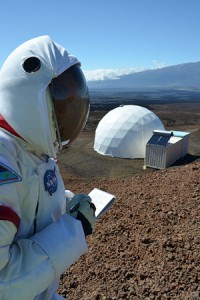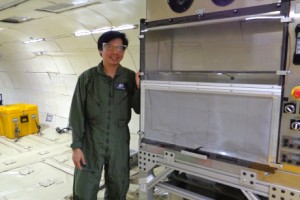
What’s on the menu for Mars? Outside the HI-SEAS (Hawaii Space Exploration Analog and Simulation) mission on the slopes of Hawaii’s Mauna Loa volcano. Cornell and the University of Hawaii at Manoa have been engaged in defining food needs for space travelers, a project funded by NASA’s Human Research Program. Credit: Sian Proctor

Postdoctoral research associate Apollo Arquiza shows what the galley (kitchen) looks like in the zero gravity G-Force 1 space simulator plane. Courtesy: Cornell
Don’t tell anybody. There may be a secret sauce to cooking in space.
Cornell researchers have taken to the air to better understand the effectiveness of a specially constructed space galley – one designed to be used on the Moon as well as Mars.
Making use of the microgravity-producing “G-Force 1” space simulator plane the team tossed tofu and shredded potatoes into pans of sizzling oil and recorded the resulting oil splatters as the plane climbed and dove in parabolic paths.
Each cycle created a brief period of partial weightlessness, simulating the conditions astronauts would face during extended stays on the Moon’s one-sixth gravity or Mars’ one-third the gravity of Earth.
The work is dedicated to better appreciate cooking 101 on other worlds.
Splatter patterns
A specially constructed space galley was jointly designed by the Cornell team with Susana Carranza of Makel Engineering in Chico, Calif.
The experimenters positioned strips of paper inside the galley fume hood and dyed the oil bright red to help them see and collect splatter patterns. Under reduced gravity conditions, the food settled more slowly into the pan, and more oil appeared to fall outside of it. The oil droplets also traveled a greater distance from the pan than under Earth conditions. That data is being analyzed to measure the particles’ size distribution and distance traveled.
Results will be used to create computer models that could be extrapolated to inform the design of future terrestrial and extraterrestrial cooking technology.
Menu fatigue
“Understanding oil spatter in reduced gravity is a big step toward designing safe and convenient cooking facilities for future space colonies,” said associate professor Jean Hunter in Cornell’s Department of Biological and Environmental Engineering.
Apollo Arquiza and Bryan Caldwell, postdoctoral research associates in the lab, were also key ingredients in devising the research onboard the G-Force 1. On the flight itself, they were aided by experts at the NASA Reduced Gravity Research Program, including astronaut Cady Coleman and Sarah Gonzales ’96, program coordinator with the Reduced Gravity Education Flight Program.
Incorporating design elements from submarine galleys and chemical fume hoods used in labs, Arquiza and Carranza created an enclosed unit with activated charcoal filters and a fan that sucks in air from the front and draws particles away from the cook.
The team had just 30 seconds to complete each experiment once a parabola began, Arquiza said in a Cornell overview written by Stacy Shackford in the College of Agriculture and Life Sciences.
The project is part of a larger investigation by Hunter’s lab into scientific and social aspects of food in space, including a simulated Mars mission in Hawaii to test resource use, menu fatigue and the benefits of home cooking in an enclosed environment, and a bed rest study to test the effects of simulated weightlessness on smell and taste perception.
By Leonard David
